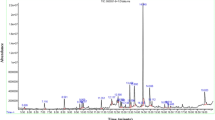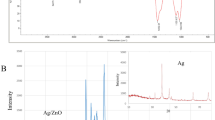Abstract
The evaluation of cytotoxic and apoptotic activities of silver nanoparticles (Ag-NPs) synthesized by aqueous extract of Prosopis farcta was investigated against lung (A549) and colon (HT-29) cell lines. The cytotoxic activity of nanoparticles was performed using MTT assay, while their apoptotic activity was tested using TUNEL method. The obtained results of MTT showed that the cell viability of A549 was dependent on the nanoparticles concentration and incubation time. Therefore, although the cytotoxic effect increased as the Ag-NPs concentration and incubation time heightened, yet the viability of HT-29 cells seems to be dependent only on the incubation time. The apoptotic results of the nanoparticles showed more than 50% of apoptosis on A549 and HT-29 cell lines, which in this case, HT-29 demonstrated 100% apoptosis at concentrations of more than 400 µg/ml. It seems that Ag-NPs synthesized using P. farcta extract can serve as anti-cancer agent in the treatment many cancers through creating or discovering new drug forms.





Similar content being viewed by others

References
Remya RR, Radhik Rajasree SR, Aranganathan L, Suman TY (2015) An investigation on cytotoxic effect of bioactive Ag NPs synthesized using Cassia fistula flower extract on breast cancer cell MCF-7. Biotechnol Rep 8:110–115
Mohammed AE (2015) Green synthesis, antimicrobial and cytotoxic effects of silver nanoparticles mediated by Eucalyptus camaldulensis leaf extract. Asian Pac J Trop Biomed 5:382–386
Gaikwad S, Ingle A, Gade A, Rai M, Falanga A, Incoronato N, Russo L, Galdiero S, Galdiero M (2014) Antiviral activity of mycosynthesized silver nanoparticles against herpes simplex virus and human parainfluenza virus type 3. Int J Nanomed 8:4303–4314
Khatami M, Mortazavi SM, Kishani-Farahani Z et al (2017) Biosynthesis of silver nanoparticles using pine pollen and evaluation of the antifungal efficiency. Iran J Biotech 15:95–101
Azizi Z, Pourseyedi S, Khatami M, Mohammadi H (2016) Stachys lavandulifolia and Lathyrus sp. mediated for green synthesis of silver nanoparticles and evaluation its antifungal activity against Dothiorella sarmentorum. J Clust Sci 27:1613–1628
Hebeish A, El-Rafie MH, EL-Sheikh MA, Seleem AA, El-Naggar ME (2014) Antimicrobial wound dressing and anti-inflammatory efficacy of silver nanoparticles. Int J Bio Macromol 65:509–515
Hussein J, El-Naggar ME, Latif YA, Medhat D, Bana ME, Refaat E, Morsy S (2018) Solvent-free and one-pot synthesis of silver and zinc oxide nanoparticles: activity toward cell membrane component and insulin signaling pathway in experimental diabetes. Colloids Surf B Biointerfaces 170:76–84
Shaheen TI, El-Naggar ME, Hussein JS, El-Bana M, Emara E, El-Khayat Z, Fouda MMG, Ebaid H, Hebeish A (2016) Antidiabetic assessment; in vivo study of gold and core-shell silver-gold nanoparticles on streptozotocin-induced diabetic rats. Biomed Pharmacother 83:865–875
Elemike EE, Fayemi OE, Ekennia AC, Onwudiwe DC, Ebenso EE (2017) Silver nanoparticles mediated by Costus afer leaf extract: synthesis, antibacterial, antioxidant and electrochemical properties. Molecules 22:701
Kirubaharan CJ, Kalpana D, Lee YS, Kim AR, Yoo DJ, Nahm KS, Kumar GG (2012) Biomediated silver nanoparticles for the highly selective copper(II) ion sensor applications. Ind Eng Chem Res 51(21):7441–7446
John Xavier SS, Karthikeyan C, Kumar GG, Kim AR, Yoo DJ (2014) Colorimetric detection of melamine using β-cyclodextrin-functionlized silver nanoparticles. Anal Methods 6:8165–8172
Gogoi N, Jayasekhar Babu P, Mahanta C, Bora U (2015) Green synthesis and characterization of silver nanoparticles using alcoholic flower extract of Nyctanthes arbortristis and in vitro investigation of their antibacterial and cytotoxic activities. Mater Sci Eng C Mater Biol Appl 46:463–469
Venugopal K, Rather HA, Rajagopal K et al (2017) Synthesis of silver nanoparticles (Ag NPs) for anticancer activities (MCF 7 breast and A549 lung cell lines) of the crude extract of Syzygium aromaticum. J Photochem Photobiol B 167:282–289
Vasanth K, Ilango K, MohanKumar R, Agrawal A, Dubey GP (2014) Anticancer activity of Moringa oleifera mediated silver nanoparticleson human cervical carcinoma cells by apoptosis induction. Colloids Surf B Biointerfaces 117:354–359
Youngs WJ, Robishaw N, Panzner MJ et al (2009) Treatment of breast cancer with silver antitumor drugs encapsulated in biodegradable polymeric nanoparticles. NSTI-Nanotech 2, 5–8
Gomaa EZ (2017) Antimicrobial, antioxidant and antitumor activities of silver nanoparticles synthesized by Allium cepa extract: a green approach. J Genet Eng Biotechnol 15:49–57
Palaniappan P, Sathishkumar G, Sankar R (2015) Fabrication of nano-silver particles using Cymodocea serrulata and its cytotoxicity effect against human lung cancer A549 cells line. Spectrochim Acta A Mol Biomol Spectrosc 138:885–890
Venugopal K, Ahmad H, Manikandan E et al (2017) The impact of anticancer activity upon Beta vulgaris extract mediated biosynthesized silver nanoparticles (Ag-NPs) against human breast (MCF-7), lung (A549) and pharynx (Hep-2) cancer cell lines. J Photochem Photobiol B 173:99–107
Swamy MK, Akhtar MS, Mohanty SK, Sinniah UR (2015) Synthesis and characterization of silver nanoparticles using fruit extract of Momordica cymbalaria and assessment of their in vitro antimicrobial, antioxidant and cytotoxicity activities. Spectrochim Acta A Mol Biomol Spectrosc 151:939–944
Krishnaraj C, Muthukumaran P, Ramachandran R, Balakumaran MD, Kalaichelvan PT (2014) Acalypha indica Linn: Biogenic synthesis of silver and gold nanoparticles and their cytotoxic effects against MDA-MB-231, human breast cancer cells. Biotechnol Rep 4:42–49
Khan Z, Al-Thabaiti SA, Yousif Obaid A, Al-Youbi AO (2011) Preparation and characterization of silver nanoparticles by chemical reduction method. Colloids Surf B Biointerfaces 82:513–517
Zhang WZ, Qiao XL, Chen JG (2006) Synthesis and characterization of silver nanoparticles in AOT microemulsion system. Chem Phys 300(3):495–500
Nasretdinova GR, Fazleeva RR, Mukhitova RK, Nizameev IR, Kadirov MK, Ziganshina AY, Yanilkin VV (2015) Electrochemical synthesis of silver nanoparticles in solution. Electrochem Commun 50:69–72
Elsupikhe RF, Ahmad MB, Shameli K, Ibrahim NA, Zainuddin N (2016) Photochemical reduction as a green method for the synthesis and size control of silver nanoparticles in κ-carrageenan. IEEE Trans Nanotechnol 15(2):209–2013
Pani A, Lee JH, Yun SII (2016) Autoclave mediated one-pot-one-minute synthesis of AgNPs and Au–Ag nanocomposite from Melia azedarach bark extract with antimicrobial activity against food pathogens. Chem Cent J 10:15
Goharshadi EK, Azizi-Toupkanloo H (2013) Silver colloid nanoparticles: ultrasound-assisted synthesis, electrical and rheological properties. Powder Technol 237:97–101
Boutinguiza M, Comesaña R, Lusquiños F, Riveiro A, del Vala J, Pou J (2015) Production of silver nanoparticles by laser ablation in open air. Appl Surf Sci 336:108–111
Miri A, Sarani M, Rezazade Bazaz M, Darroudi M (2015) Plant-mediated biosynthesis of silver nanoparticles using Prosopis farcta extract and its antibacterial properties. Spectrochim Acta A Mol Biomol Spectrosc 141:287–291
Sriranjani R, Srinithya B, Vellingiri V et al (2016) Silver nanoparticle synthesis using Clerodendrum phlomidis leaf extract and preliminary investigation of its antioxidant and anticancer activities. J Mol Liq 220:926–930
Ramar M, Manikandan B, Marimuthu PN et al (2015) Synthesis of silver nanoparticles using Solanum trilobatum fruits extract and its antibacterial, cytotoxic activity against human breast cancer cell line MCF 7. Spectrochim Acta A Mol Biomol Pectrosc 140:223–228
Moaddab S, Ahari H, Shahbazzadeh D et al (2011) Toxicity study of nanosilver (Nanocid®) on osteoblast cancer cell line. Int Nano Lett 1:11–16
Jeyaraj M, Rajesh M, Arun R et al (2013) An investigation on the cytotoxicity and caspase-mediated apoptotic effect of biologically synthesized silver nanoparticles using Podophyllum hexandrum on human cervical carcinoma cells. Colloids Surf B Biointerfaces 102:708–717
Sathishkumar G, Gobinath C, Wilson A et al (2014) Dendrophthoe falcata (Lf) Ettingsh (Neem mistletoe): a potent bioresource to fabricate silver nanoparticles for anticancer effect against human breast cancer cells (MCF-7). Spectrochim Acta A Mol Biomol Spectrosc 128:285–290
Sankar R, Karthik A, Prabu A et al (2013) Anticancer activity of Ficus religiosa engineered copper oxide nanoparticles. Colloids Surf B Biointerfaces 108:80–84
Sulaiman GM, Mohammed WH, Marzoog TR, AA et al (2013) Green synthesis, antibacterial and cytotoxic effects of silver nanoparticles using Eucalyptus chapmaniana leaves extract. Asian Pac J Trop Biomed 3:58–63
Gajendran B, Chinnasamy A, Durai P, Raman J, Ramar M (2014) Biosynthesis and characterization of silver nanoparticles from Datura inoxia and its apoptotic effect on human breast cancer cell line MCF7. Mater Lett 122:98–102
Acknowledgements
This work was supported by Zabol University of Medical Sciences.
Author information
Authors and Affiliations
Corresponding author
Ethics declarations
Conflict of interest
The authors declare that they have no conflict of interest.
Ethical approval
The research was performed on cytotoxic and apoptotic activities of silver nanoparticles (Ag-NPs) against lung (A549) and colon (HT-29) cell lines. The cytotoxic activity of nanoparticles was performed using MTT assay, while their apoptotic activity was tested using TUNEL method. The lung (A549) and colon (HT-29) cell lines were prepared from Pasteur Institute of Iran. Therefore, this research does not require the approval of Animal Experimentation Committee.
Rights and permissions
About this article
Cite this article
Miri, A., Sarani, M. Biological studies of synthesized silver nanoparticles using Prosopis farcta. Mol Biol Rep 45, 1621–1626 (2018). https://doi.org/10.1007/s11033-018-4299-0
Received:
Accepted:
Published:
Issue Date:
DOI: https://doi.org/10.1007/s11033-018-4299-0



